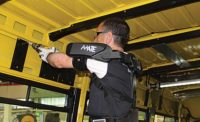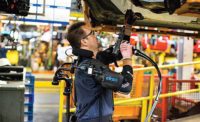Hyundai Develops Exoskeletons

SEOUL—Engineers at Hyundai Motor Group have developed exoskeleton technology to address ergonomic issues and concerns on its assembly lines. Their wearable devices include the Hyundai Chairless Exoskeleton (H-CEX) and the Hyundai Vest Exoskeleton (H-VEX).
“The robotics field not only offers future mobility solutions, but also presents alternative solutions to reduce productivity decline in the workforce,” says Youngcho Chi, executive vice president and chief innovation officer at Hyundai Motor Group. “[We] plan to utilize [our] extensive technological database collected from autonomous vehicle production experience to drive the company’s success in the robotics field.”
The H-CEX is a knee joint protective device that helps maintain a person’s sitting position. The 1.6-kilogram device can withstand weights of up to 150 kilograms. “With waist, thigh and knee belts, it can be easily equipped and adjusted to the user’s height,” explains Chi. “It also features three different angle settings.
Along with the H-CEX, Hyundai has been testing the H-VEX at its North American factories.
“The H-VEX is a device that alleviates pressure on the workers’ neck and back by adding 60 kilograms of strength to the user when their arms are used overhead,” says Chi. “It is expected to be very effective at preventing injury and increasing work efficiency.”
Looking for a reprint of this article?
From high-res PDFs to custom plaques, order your copy today!





